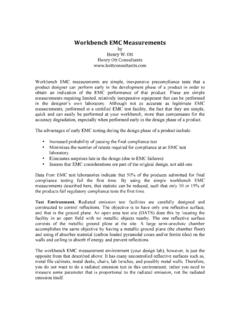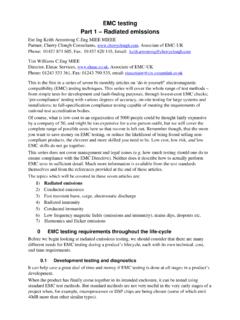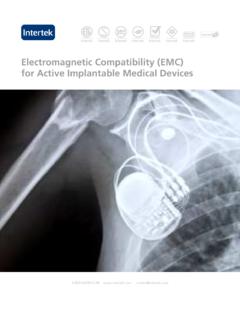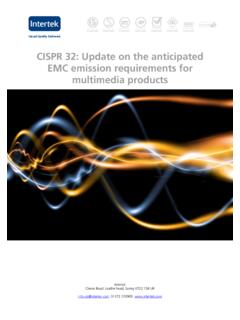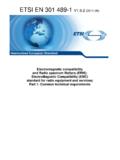Transcription of Automotive EMC Testing – The Challenges of Testing …
1 Automotive EMC Testing The Challenges of Testing battery Systems for Electric and Hybrid Vehicles1. Defining the Test Methodology using system Engineering This paper is adapted by Terry M. North of Jastech EMC Consulting, LLC from a presentation by James Muccioli of Jastech EMC Consulting, LLC at the 2011 IEEE EMC Symposium Transportation Systems EMC workshop. The presentation was coauthored by Dale Sanders of Jastech EMC Consulting, LLC. Abstract Hybrid and electric vehicle batteries are actually an Energy Storage system whose internal module functions include: What is New to EMC Testing ?
2 battery monitoring and control, DC to DC convertor(s), an internal battery charger and internal battery cooling control. As a result, We are not just Testing a battery module, but an Energy Storage comprehensive EMC Testing requires a paradigm shift from module system . or component level Testing to complete EMC system level Testing . The paradigm shift is moving to complete EMC system level test- ing from module or component level Testing . Introduction The Energy Storage system can be designed with the following The focus of this presentation is to share the Challenges and flexi- modules: bility that a test facility needs to address in order to accommodate 1.
3 battery control module OEM approved Test Plans and development Testing . 2. DC to DC convertor module 3. Internal battery charger The density of packaging and complexity of hybrid and electric 4. Internal battery cooling module vehicle battery systems is readily apparent in the following photos. 5. Other modules Adapted from the presentation of the same name included in the workshops/tutorials of the 2011 IEEE International Symposium on electromagnetic compatibility . 2012 IEEE electromagnetic compatibility Magazine Volume 1 Quarter 1 97. Traceable: in reference to requirements; a requirement is said to Writing an EMC Test Plan be traceable if one can identify its source.
4 The source may be a higher level requirement or a source document defining its The person writing an EMC Test Plan must understand three existence. An example would be if a component level require- things about the Device Under Test (DUT) or system Under ment (weight, reliability) is traceable back to a vehicle level Test (SUT). requirement. 1. What EMC standards should the SUT be tested to and how do they apply to the test setup? Operational Concept: an operational concept is a shared vision 2. What are the operating states of the SUT to be tested?
5 From the perspective of the users and development participants of 3. What are the conditions when an RF field is applied or mea- how the system will be developed, produced, deployed, trained, sured that determines a pass or failure criteria for the SUT? operated, maintained, refined and retired to meet the operational needs and objectives. Systems Engineering Approach to EMC. Step 2-3 - Identify, Discover and Understand Requirements Before discussing the process for developing good requirements, some important definitions must be established: Identify Source of Requirements: system : a set of components acting together to achieve a set of North American, Asian and European Module EMC standards common objectives via the accomplishment of a set of tasks.
6 Military standards system Behavior: a sequence of functions or tasks, with inputs and outputs that must be performed to achieve a specific objective. Discover and Understand Requirements: Radiated RF Emissions Requirement: mandates that something must be accomplished, Conducted RF Emissions transformed, produced, or provided. The attributes of a good RF Immunity requirement are that it is unambiguous, understandable, traceable, Magnetic Field Immunity correct, concise, unique and verifiable. Power Cycling and Transient Immunity Electrostatic Discharge 98 2012 IEEE electromagnetic compatibility Magazine Volume 1 Quarter 1.
7 How do these requirements change for an Energy Storage system ? Considering the size and weight of a typical hybrid or electric battery system , how will this be handled in the immunity and emission tests ? Things to Consider in Testing a system Will the test lab have the capability for increased monitoring of the various modules in the system during Testing ? If the vehicle supplies the loads, charging and regenerative charg- What additional equipment is needed to simulate sensors, ing from braking to the Energy Storage system : loads, data bus, etc.
8 Of the vehicle operation of the system What would be required to mimic the vehicle interactions when Under Test? Testing the system ? How would this system level Testing affect the test time required when running through the different modes of operation? Radiated RF Emissions and Immunity Are there additional modes or longer dwell times required to adequately assess the system response? Another thing to consider in performing a radiated emissions If the Testing is not done at the system level first, what will be the or immunity test is how to place and activate the high and impact to the number of vehicles required for verification (not low voltage wiring harnesses for the Energy Storage system .)
9 Validation) at the vehicle level? Some options: Note: Validation is confirming that a product or service meets the Testing the low voltage wiring harness with no power to the high requirements. voltage harness. Testing the high voltage wiring harness with no power to the low Verification is the process for quantifying and accepting the requirements. voltage harness. Testing with power to both high and low voltage wiring harnesses. Things that Must be Addressed in the Test Plan Testing with power to both high and low voltage wiring harness- es, but shield the high voltage wiring harness.
10 Due to the size, weight and complexity of the Energy Storage Sys- Other possible modes. tem, the following items need to be addressed with the test lab and documented in the test plan: 2012 IEEE electromagnetic compatibility Magazine Volume 1 Quarter 1 99. 2. Will the sensors be affected by the transients and give bad data to the system ? 3. Define a way to monitor the contactors on the high voltage side to tell if they are truly open or closed. 4. Define where a DVM must be used to measure the voltage and current at different places in the system before and after the test Electrostatic Discharge Bench Test 1.




